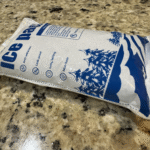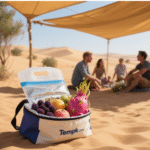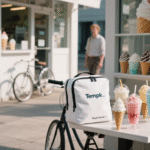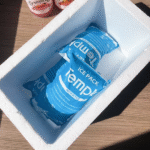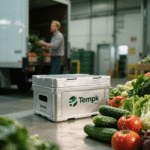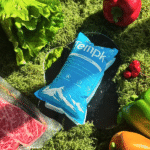What temperature are dry ice packs under real shipping conditions? A presión estándar, dry ice sits at −78.5 °C (-109,3 °F). In a shipper, internal air typically holds between about −70 °C and −20 °C depending on insulation, desfogue, and pack placement. You’ll see why this range matters, how much dry ice to use, and how to stay compliant in 2025.

-
Exact numbers: what temperature are dry ice packs en la superficie, in the box air, and at the product core
-
Sizing made simple: quick math for sublimation rates and a dry ice quantity estimator
-
Safer pack-outs: desfogue, etiquetas (UN1845), and spacing to prevent freeze damage
-
Smart choices: when dry ice beats gel/PCM—and when it doesn’t
-
Tendencias para 2025: vent membranes, edge-aware loggers, recuperación de CO₂, and digital DG workflows
What temperature are dry ice packs under real shipping conditions?
Respuesta corta: Dry ice is −78.5 °C at the source; box air stabilizes warmer (≈ −70 °C to −20 °C). Product core lags the air and stays below its spec if you size mass and insulation correctly. This is why what temperature are dry ice packs is a system question, not just a single number.
Por que importa: If you must hold ≤−18/−20 °C (helado, postres congelados, algunos biológicos), a −78.5 °C “cold battery” gives large safety headroom. For 2–8 °C, el hielo seco es too cold—use gel or PCM to avoid accidental freezing.
How much dry ice to start with?
A practical daily estimator is:
hielo seco (lb) = (Horas de tránsito ÷ 24) × Sublimation rate (lb/24 h)
Plan with typical rates by shipper quality and add a 10–30 % buffer for hand-offs and ambient spikes.
| Tipo de remitente | Calidad de aislamiento | Sublimación típica (lb/24 h) | Lo que significa para ti |
|---|---|---|---|
| Espuma EPS (≈ 2″ wall) | Excelente | 4–6 | Great for 48–72 h lanes |
| Rigid plastic + transatlántico | Bien | 6–8 | Balanced cost/hold |
| Acanalado + transatlántico | Moderado | 8–10 | Add mass or shorten route |
| Pallet foam crate | De primera calidad | 10–20 / paleta | Scale with openings and cube |
Para la punta: It’s often cheaper to mejorar el aislamiento than to keep adding dry ice. Better walls reduce loss across every touchpoint.
Pack placement patterns that actually work
-
Top-load only: fregaderos fríos; watch bottom warm-up on longer lanes
-
Arriba + abajo: flatter gradients for mixed-density loads
-
Rodear (lados + arriba): most uniform profile; needs more initial mass
-
Interstitial (between layers): desplegable rápido; add spacers for fragile packs
Instantánea del mundo real: A dessert brand cut temperature excursions by 38 % after switching from top-only blocks to a surround pellet pattern with the same mass.
What temperature are dry ice packs vs. gel and PCM packs?
Final: Use dry ice for frozen (≤−20 °C). Use gel/PCM for 2–8 °C or CRT.
| Cooling Element | Set-Point / Behavior | El mejor uso | Vigilancias |
|---|---|---|---|
| hielo seco (CO₂ UN1845) | −78.5 °C sublimes | Deep-frozen lanes | Se requiere ventilación |
| Paquete de gel (0 °C) | 0 °C melts | Comida fría | Short hold |
| PCM −21 °C | Phase at −21 °C | Alimentos congelados | Condición previa |
| PCM +5 °C | Phase ≈ +5 °C | Vacunas | Evite la congelación |
| PCM +22 °C | Phase ≈ +22 °C | CRT lanes | Needs insulation |
What temperature are dry ice packs at the product interface—and is it safe?
Contact risk: A −78.5 °C surface can freeze sensitive items on contact. Add a spacer (acanalado, foam tray) and distribute packs evenly.
Lista de verificación de cumplimiento
-
Proper name “Carbon dioxide, sólido (hielo seco), ONU1845”
-
Net weight of dry ice on package
-
Ventilado (Nunca es hermético) recipiente
-
Clase 9 etiqueta de peligro
-
Clear shipper / consignee info
| Tema | Essential Practice | Qué evitar | Por que importa |
|---|---|---|---|
| Desfogue | Use vent gaps | Airtight lids | Previene la acumulación de presión |
| Etiquetado | UN1845 + peso + Clase 9 | Missing weights | Aceptación más rápida |
| Manejo | Guantes aislados | Contacto con las manos desnudas | Avoids frost injury |
Consejos prácticos
-
Door cycles: minimize openings
-
Logger location: near payload core
-
Lane design: prefer predictable curves, not perfect symmetry
How much dry ice do you need for 24–96 h lanes?
Ejemplo: 48 h lane, remitente de EPS, ≈ 5 lb / 24 h →
(48 / 24) × 5 = 10 lb + 10–20 % búfer → 11–12 lb total.
Validation beats theory—tune to your kit and lanes.
2025 trends in dry ice temperature control
Fresco en 2025: Smarter vent membranes, edge-aware loggers, Co₂ recapturado, and digital DG workflows cut cost and emissions.
Highlights
-
Microporous vent lids stabilize internal air
-
Edge-aware loggers catch corner leaks early
-
Lower-carbon dry ice from CO₂ capture
-
Digital declarations reduce errors
Insight del mercado: Frozen DTC and biologics growth favors lighter, surround pack-outs with better insulation for cost control.
Preguntas frecuentes
Q1: What temperature are dry ice packs at the start of a trip?
About −78.5 °C at surface/core; internal air warms to −70 °C to −20 °C depending on design.
Q2: Can I use dry ice for 2–8 °C?
No. It’s too cold—use +5 °C PCM or gel packs.
Q3: Pellets or slabs?
Pellets distribute evenly; las losas duran más. Hybrid works best.
Q4: How close can dry ice be to my product?
Evite el contacto directo; use a spacer and rely on box air temp.
Q5: ¿Cuánto dura el hielo seco??
Typically 18–96 h depending on insulation, masa, y ambiente.
Resumen & recomendaciones
Puntos clave: What temperature are dry ice packs = −78.5 °C source; box air warmer.
Use dry ice for frozen lanes, PCM/gel for 2–8 °C. Always vent, etiqueta, y registrar.
Siguientes pasos:
-
Definir temperatura objetivo & tiempo de carril.
-
Choose correct coolant.
-
estimar masa + 10–30 % buffer.
-
Use Top+Bottom or Surround layout.
-
Validar con registradores.
CTA: Ready to validate a −20 °C or −70 °C lane? Book a 10-minute pack-out review with Tempk.
Acerca de Tempk
We design validated frozen, refrigerado, and CRT pack-outs with proven insulation and accessories that hit −20 °C and −70 °C profiles reliably. Every design is backed by pilot data and SOPs that teams can follow easily.
















